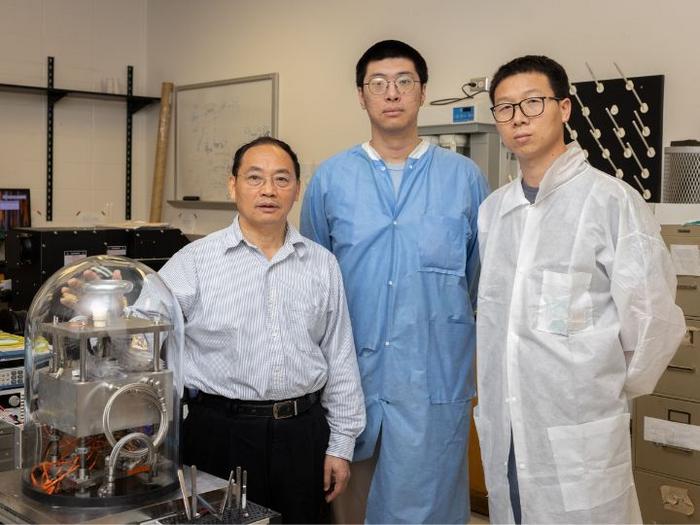Regulating the Structural Transformations of Protein Aromatic Side Chains
In an extraordinary advancement in the field of protein engineering, researchers from the Institute of Science Tokyo have demonstrated a groundbreaking approach to controlling and visualizing protein dynamics at the molecular level. Their findings, detailed in the latest issue of Advanced Science, highlight how ligand binding can orchestrate changes in the orientation and movement of […]


In an extraordinary advancement in the field of protein engineering, researchers from the Institute of Science Tokyo have demonstrated a groundbreaking approach to controlling and visualizing protein dynamics at the molecular level. Their findings, detailed in the latest issue of Advanced Science, highlight how ligand binding can orchestrate changes in the orientation and movement of aromatic side chains within a novel protein cage structure. This discovery is poised to re-shape our understanding of protein dynamics, with implications for various fields ranging from medicine to biotechnology.
The core of this research centers on a distinctive protein cage known as ferritin, which encases specially engineered “pockets.” These pockets are strategically designed to influence the arrangement of aromatic amino acids surrounding them. The researchers ingeniously utilized fluorescent ligands to trigger these pockets, demonstrating that such binding initiates a coordinated series of molecular changes, akin to a domino effect, impacting the behavior of aromatic side chains. This intricate interplay underscores the remarkable potential of protein cages to exhibit tunable fluorescence properties, enhancing their utility in responsive biomaterials.
Protein dynamics are integral to the vast array of cellular functions, with conformational changes in proteins occurring on a near-nanoscale level. The link between a protein’s function and its structural flexibility is critical — without the ability to bend, fold, and shift in response to environmental stimuli, proteins would fail to carry out essential processes such as chemical signaling, cellular metabolism, and even apoptosis. This fundamental relationship gives rise to a myriad of opportunities for harnessing protein behavior in scientific and medical applications.
Aromatic interactions, characterized by the stacking and orientation of aromatic side chains, are central to many biochemical processes, including protein folding and molecular recognition. The challenge has always been to finely tune these interactions, especially at an atomic level, to enhance the efficiency and specificity of protein-based applications. Prior to this research, advances in this area had been limited, proving a significant barrier to the development of innovative biomaterials and technologies.
In their experimental study, led by Professor Takafumi Ueno, the team meticulously designed protein cages with varying aromatic side-chain configurations, allowing for the observation of different responses based on ligand structure. This level of detailed analysis was made possible through advanced X-ray crystallography techniques, enabling the researchers to visualize and quantify the substantial changes elicited by ligand binding. Such precision in molecular behavior presents an invaluable resource for future research endeavors, allowing scientists to engineer protein interactions with unprecedented control.
In addition to their role in enhancing the basic understanding of protein interactions, the implications of this research are vast. For instance, the ability to control protein dynamics has significant potential in drug delivery applications. It paves the way for developing systems that could transport therapeutics more effectively, particularly for compounds known to have poor solubility or stability in physiological conditions. The implications of such an advance extend to various therapeutic areas, including cancer treatment and targeted drug administration.
Moreover, the approach detailed in this study opens up exciting avenues for the development of biomolecular robotics. The concept of utilizing proteins that respond dynamically to external stimuli could revolutionize how we imagine future applications in robotics, automation, and even environmental sensors. By applying this technology, scientists may be able to create systems that not only react to environmental changes but also adapt in real time to perform specific tasks, thus blurring the lines between biological and synthetic intelligence.
The researchers have also highlighted that the fluorescent properties of the ligands change distinctly in the presence of these aromatic pockets, showcasing potentials for enhanced biosensing applications. Fluorescent proteins serve as vital tools in cellular imaging, and the ability to tune their properties could significantly elevate our capacity for novel imaging techniques. With the current study setting a benchmark for the control of protein dynamics, scholars and industry professionals alike are encouraged to leverage these findings to explore new methodologies in biosensor design.
While the potential applications are fervently promising, it is essential to note the robust nature of the research’s findings. The meticulous design specifications allow researchers to systemically alter side-chain orientations, fostering an understanding of how such molecular configurations can lead to enhanced function. This insight not only showcases the team’s remarkable scientific aptitude but also feeds into a broader narrative of advancing molecular biology and materials science hand in hand.
In summary, the Institute of Science Tokyo’s innovative research represents a trailblazing effort toward orchestrating protein dynamics through ligand interactions. With the potential to influence everything from biomaterials to medicinal chemistry, such research is reflective of the burgeoning field of protein engineering and light regulation. As researchers continue to delve deeper into the molecular complexities of proteins, we are likely to witness transformative breakthroughs that redefine our approaches to medicine, biotechnology, and synthetic biology, fundamentally changing the trajectory of these fields.
One cannot underscore enough the importance of collaboration in such pioneering research. The effort of interdisciplinary teams within the institute undeniably contributed to the multifaceted approach observed in this study. By merging expertise in biochemistry, molecular biology, and chemical engineering, they have set a strong foundation for future explorations in the realm of protein dynamics.
The ramifications of this research are vast and multifaceted. Scientists and practitioners across various disciplines will undoubtedly find value in the study not only for its immediate applications but also as a springboard for further exploration into the nuanced relationships between ligands, aromatic interactions, and protein function. Such comprehensive investigations are crucial for nurturing the next generation of scientific innovation.
The journey ahead is filled with vast possibilities as we stand on the cusp of a new age in protein engineering, where controlling molecular interactions opens the door to unprecedented advancements in health, technology, and sustainable material development. The ongoing synergy between theoretical research and practical application is where the true power of science resides, and this study serves as an embodiment of that ethos.
The meticulous approach of the research team illustrates that they recognized the complexity of proteins and their interactions, and more importantly, that they embraced this complexity as a basis for innovation. The ability to visualize and manipulate protein dynamics fundamentally alters the landscape of what is possible, energizing the quest for knowledge and innovation that defines science as a whole.
As scientists worldwide look to replicate and build upon this foundational work, one can only imagine the innovations and discoveries that lie in wait within the rich tapestry of molecular interactions. The exciting intersection of technology with the intricate behaviors of proteins promises to usher in new forms of scientific inquiry, ultimately benefiting society as a whole.
In conclusion, the research conducted by the Institute of Science Tokyo not only advances our understanding of protein dynamics but also sets the stage for transformative applications across various fields. With the continued exploration of the principles governing molecular interactions, the future of protein engineering looks bright and full of promise.
Subject of Research: Protein dynamics and control through ligand binding
Article Title: Design of Aromatic Interaction Networks in a Protein Cage Modulated by Fluorescent Ligand Binding
News Publication Date: 20-Feb-2025
Web References: http://doi.org/10.1002/advs.202417030
References: Advanced Science Journal
Image Credits: Institute of Science Tokyo
Keywords
Aromatic interactions, protein engineering, ligand binding, fluorescence properties, biomaterials, drug delivery, biosensors, molecular dynamics, protein cages, X-ray crystallography, collaborative research, biotechnology.
Tags: aromatic amino acids arrangementengineered protein structuresferritin protein research advancementsligand binding effects on proteinsmolecular changes in proteinsprotein aromatic side chains dynamicsprotein cage fluorescence propertiesprotein engineering breakthroughsprotein structure regulationresponsive biomaterials in medicinetunable biomaterials in biotechnologyvisualization of protein dynamics
What's Your Reaction?

































